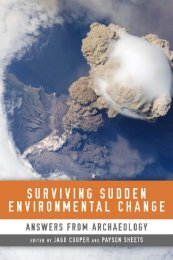Utatlan: The Constituted Community of the K'iche Maya of Q'umarkaj
Utatlan: The Constituted Community of the K'iche Maya of Q'umarkaj
Utatlan: The Constituted Community of the K'iche Maya of Q'umarkaj
You also want an ePaper? Increase the reach of your titles
YUMPU automatically turns print PDFs into web optimized ePapers that Google loves.
<strong>The</strong> Greater Utatlán Project<br />
tern.” <strong>The</strong> cities were characterized by social diversity, but with most residents being<br />
commoner farmers; o<strong>the</strong>r identifiable economic activities could vary considerably<br />
from one city to ano<strong>the</strong>r. Some large cities, such as Tikal, may have had limited<br />
capacity for production <strong>of</strong> utilitarian goods, and this may have contributed to a low<br />
population density. Political administration and ritual activities were central and<br />
<strong>the</strong> city center was dominated by large palaces and major temples, as well as a ball<br />
court (Smith 2002: 11–16). <strong>The</strong> major point in Smith’s essay (2002: 18), however,<br />
is that <strong>the</strong> earliest cities across <strong>the</strong> world vary greatly one from ano<strong>the</strong>r, with <strong>the</strong>ir<br />
form determined by <strong>the</strong> larger context <strong>of</strong> <strong>the</strong> kind <strong>of</strong> society in which <strong>the</strong>y were<br />
found.<br />
Smith (2005) examined <strong>the</strong> nature <strong>of</strong> Postclassic Mesoamerican urban centers<br />
on a regional basis, defining urban-type settlements as sites both having public<br />
buildings and generally, but not necessarily, exceeding 10 ha in size. He fur<strong>the</strong>r<br />
classified cities by functional type. <strong>The</strong>se types included major political capitals,<br />
political towns (<strong>the</strong> most common type, with sixty-four represented), and political<br />
towns with fur<strong>the</strong>r specialization identified (political town, craft specialization;<br />
political town, trade specialization; political town, religious specialization). He had<br />
eighty-seven sites in his sample, with twenty-four (his second largest subset) located<br />
in his sou<strong>the</strong>ast area, which included highland Guatemala. <strong>The</strong> Postclassic cities<br />
were similar to earlier ones in Mesoamerica, containing an epicenter with temples,<br />
palaces, ball courts, and plazas. <strong>The</strong>ir median extent was 90 ha. In general, <strong>the</strong>ir<br />
epicenters appeared to be carefully planned, whereas <strong>the</strong> adjacent residential areas<br />
lacked such planning. <strong>The</strong> median epicenter size in <strong>the</strong> highland Guatemala area<br />
was 1.9 ha, although Q’umarkaj measured 11 ha and Chisalin 4 ha. Smith found<br />
that “<strong>the</strong> most striking variation in Postclassic urban size relates to political status,”<br />
suggesting that administrative functions were important determinants in city size<br />
(2005: 421).<br />
Trade as a Framework for Conceptualizing <strong>the</strong> Archaeological Record<br />
Ano<strong>the</strong>r method for exploring <strong>the</strong> nature <strong>of</strong> archaeological community organization<br />
and regional integration focuses on trade and economic interactions among<br />
peoples irrespective <strong>of</strong> <strong>the</strong>ir specific level <strong>of</strong> political integration or population<br />
nucleation and specialization (Polyani 1975; Renfrew 1975; Webb 1975). Aspects<br />
<strong>of</strong> trade and redistribution can serve as an integrating principle for chiefdoms<br />
(Renfrew 1975: 8ff ) or as a force governing territorial structure and state formation<br />
(Renfrew 1975: 13ff ). Frances Berdan (2003) provided a summary description<br />
<strong>of</strong> trade and <strong>the</strong> economic foundations <strong>of</strong> Postclassic Mesoamerica. Many <strong>of</strong> <strong>the</strong><br />
utilitarian items may have been locally produced, and elite households may have<br />
also produced some luxury goods, but <strong>the</strong>re were extensive trading networks to<br />
21





